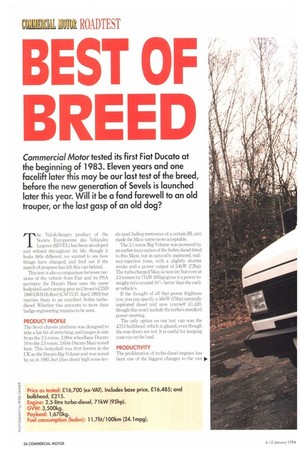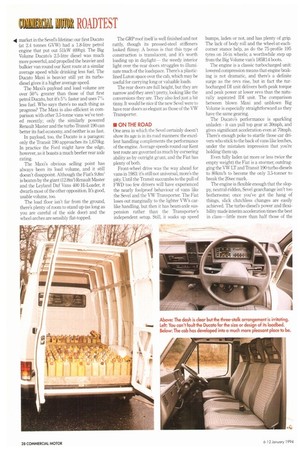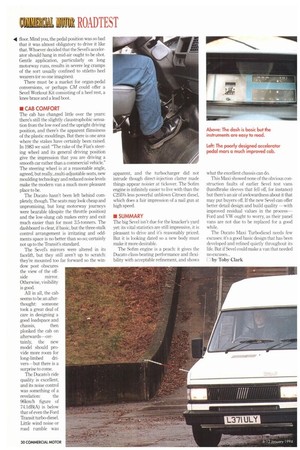S i I I
Page 28

Page 30

Page 31

Page 32

If you've noticed an error in this article please click here to report it so we can fix it.
BR
Commercial Motor tested its first Fiat Ducato at the beginning of 1983. Eleven years and one facelift later this may be our last test of the breed, before the new generation of Sevels is launched later this year. Will it be a fond farewell to an old trouper, or the last gasp of an old dog?
The Val-di-Sangro product of the Societe Europeenne des Vehicules Legeres (SEVEL) has been developed and refined throughout its life, though it looks little different: we wanted to see how things have changed, and find out if the march of progress has left this van behind.
This test is also a comparison between versions of the vehicle from Fiat and its PSA partners: the Ducato Maxi uses the same bodyshell and running gear as Citroen's C25D 1800 LWB Ili-Roof (CM 15-21 April 1993) but marries them to an excellent Sofim turbodiesel. Whether this amounts to more than badge engineering remains to be seen.
PRODUCT PROFILE The Sevel chassis platform was designed to take a fair bit of stretching, and ranges in size from the 2.5-tonne, 2.90m wheelbase Ducato 10 to the 3.5-tonne, 3.65m Ducato Maxi tested here. This lxiclyshell was first known in the UK as the 1)ucato Big Volume and was tested by us in 1985, but jibes about high noise lev els (and fading memories of a certain BL car) made the Maxi name more acceptable.
The 3.1-tonne Big Volume was powered by an earlier incarnation of the Sofim diesel fitted to this Maxi, but in naturally aspirated, indirect-injection form, with a slightly shorter stroke and a power output of 54kW (72hp). The turbocharged Maxi is heavier, but even at 3.5 tonnes its 71kW (95hp) gives it a power-toweight ratio around 16° (i better than the earlier vehicle's.
If the thought of all that power frightens you, you can specify a 56kW (75hp) naturally aspirated diesel and save yourself £1,420, though this won't include the turbo's standard power steering.
The only option on our test van was the .C215 bulkhead, which is glazed, even though the rear doors are not. It is useful for keeping your eye on the load.
PRODUCTIVITY The proliferation of turbo-diesel engines has been one of the biggest changes to the van 10.
4 market in the Sevel's lifetime: our first Ducat° (at 2.4 tonnes GVVV) had a 1.8-litre petrol engine that put out 51kW (69hp). The Big Volume Ducato's 2.5-litre diesel was much more powerful, and propelled the heavier and bulkier van round our Kent route at a similar average speed while drinking less fuel. The Ducat° Maxi is heavier still yet its turbodiesel gives it a higher average speed.
The Maxi's payload and load volume are over 50% greater than those of that first petrol Ducato, but it's 5% faster and uses 7% less fuel. Who says there's no such thing as progress? The Maxi is also efficient in comparison with other 3.5-tonne vans we've tested recently; only the similarly powered Renault Master and the turbo Transit 190 can better its fuel economy, and neither is as fast.
In payload, too, the Ducat° is a paragon: only the Transit 190 approaches its 1,670kg. In practice the Ford might have the edge, however, as it boasts a much beefier rear axle rating.
The Maxi's obvious selling point has always been its load volume, and it still doesn't disappoint. Although the Fiat's 9.8mr' is beaten by the giant (12.8&) Renault Master and the Leyland Daf Vans 400 Hi-Loader, it dwarfs most of the other opposition. It's good, usable volume, too.
The load floor isn't far from the ground, there's plenty of room to stand up (as long as you are careful of the side door) and the wheel-arches are sensibly flat-topped. The GRP roof itself is well finished and not rattly, though its pressed-steel stiffeners looked flimsy. A bonus is that this type of construction is translucent, and it's worth loading up in daylight— the weedy interior light over the rear doors struggles to illuminate much of the loadspace. There's a plasticlined Luton space over the cab, which may be useful for carrying long or valuable loads.
The rear doors are full height, but they are narrow and they aren't pretty, looking like the conversions they are. They also feel just a bit tinny. It would be nice if the new Sevel were to have rear doors as elegant as those of the VW Transporter.
• ON THE ROAD One area in which the Sevel certainly doesn't show its age is in its road manners: the excellent handling complements the performance of the engine. Average speeds round our Kent test route are governed as much by cornering ability as by outright grunt, and the Fiat has plenty of both.
Front-wheel drive was the way ahead for vans in 1983: it's still not universal, more's the pity. Until the Transit succumbs to the pull of FWD too few drivers will have experienced the nearly foolproof behaviour of vans like the Sevel and the VW Transporter. The Fiat loses out marginally to the lighter VW's car. like handling, but then it has beam-axle suspension rather than the Transporter's independent setup. Still, it soaks up speed bumps, laden or not, and has plenty of grip. The lack of body roll and the wheel-at-eachcorner stance help, as do the 75-profile 195 tyres on 16-in wheels; a worthwhile step up from the Big Volume van's 185R14 boots.
The engine is a classic turbocharged unit: lowered compression means that engine braking is not dramatic, and there's a definite surge as the revs rise, but in fact the turbocharged DI unit delivers both peak torque and peak power at lower revs than the naturally aspirated IDI unit. The comparison between blown Maxi and unblown Big Volume is especially straightforward as they have the same gearing.
The Ducato's performance is sparkling unladen it can pull top gear at 30mph, and gives significant acceleration even at 70mph. There's enough poke to startle those car drivers who stick to the back of vans like leeches, under the mistaken impression that you're holding them up.
Even fully laden (at more or less twice the empty weight) the Fiat is a stormer, outdragging the VW LT and Transit 190 turbo-diesels to 801cm/h to become the only 3.5-tonner to break the 20sec mark, The engine is flexible enough that the sloppy, neutral-ridden, Sevel gearchange isn't too bothersome; once you've got the hang of things, slick clutchless changes are easily achieved. The turbo-diesel's power and flexibility made interim acceleration times the best in class—little more than half those of the unblown Big Volume, with fewer gearchanges.
The Ducato's brakes seem to be up to the job of controlling its speed; we were unable to perform our usual brake tests on the wet Chobham track, but the Fiat's setup inspired confidence on the road.
Unfortunately the handbrake disappointed us on Chobham's test hills: the laden Oucato wouldn't hold on a 1-in-4 up or down, though (with a bit of footbrake juggling and a lot of protest from the front tyres) it would restart pointing uphill. The handbrake may have been poorly adjusted but this really isn't good enough.
We were impressed by the Ducato's engine. and it was fun to drive with one's foot to the • floor. Mind you, the pedal position was so bad that it was almost obligatory to drive it like that. Whoever decided that the Severs accelerator should hang in mid-air ought to be shot. Gentle application, particularly on long motorway runs, results in severe leg cramps of the sort usually confined to stiletto heel wearers (or so one imagines).
There must be a market for organ-pedal conversions, or perhaps CM could offer a Sevel Workout Kit consisting of a heel rest, a knee brace and a lead boot.
• CAB COMFORT The cab has changed little over the years: there's still the slightly claustrophobic sensation from the low roof and the upright driving position, and there's the apparent flimsiness of the plastic mouldings. But there is one area where the stakes have certainly been raised. In 1983 we said: The rake of the Fiat's steering wheel and its general driving position give the impression that you are driving a smooth car rather than a commercial vehicle." The steering wheel is at a reasonable angle, agreed, but really..multi-adjustable seats, new moulding technology and reduced noise levels make the modern van a much more pleasant place to be.
The Ducato hasn't been left behind completely, though. The seats may look cheap and unpromising, but long motorway journeys were bearable (despite the throttle position) and the low-slung cab makes entry and exit much easier than for most 3.5-tonners. The dashboard is clear, if basic, but the three-stalk control arrangement is irritating and oddments space is no better than so-so; certainly not up to the Transit's standard.
The Severs mirrors were altered in its facelift, but they still aren't up to scratch: they're mounted too far forward so the window post obscures the view of the off side mirror. Otherwise, visibility is good.
All in all, the cab seems to be an afterthought: someone took a great deal of care in designing a good loadspace and chassis, then plonked the cab on afterwards—certainly, the new model should provide more room for long-limbed drivers—but there is a surprise to come.
The Ducato's ride quality is excellent, and its noise control was something of a revelation: the 96km/h figure of 74.1dB(A) is below that of even the Ford Transit turbo-diesel. Little wind noise or road rumble was apparent, and the turbocharger did not intrude though direct-injection clatter made things appear noisier at tickover. The Sofim engine is infinitely easier to live with than the C25D's less powerful unblown Citroen diesel, which does a fair impression of a nail gun at high speed.
• SUMMARY
The big Sevel isn't due for the knacker's yard yet: its vital statistics are still impressive, it is pleasant to drive and it's reasonably priced. But it is looking dated so a new body must make it more desirable.
The Sofim engine is a peach: it gives the Ducato class-beating performance and flexibility with acceptable refinement, and shows what the excellent chassis can do.
This Maxi showed none of the obvious construction faults of earlier Sevel test vans (handbrake sleeves that fell off, for instance) but there's an air of awkwardness about it that may put buyers off. If the new Sevel can offer better detail design and build quality —with improved residual values in the process— Ford and VW ought to worry, as their panel vans are not due to be replaced for a good while.
The Ducato Maxi Turbodiesel needs few excuses: it's a good basic design that has been developed and refined quietly throughout its life. But if Sevel could make a van that needed no excuses...
1 by Toby Clark








































































